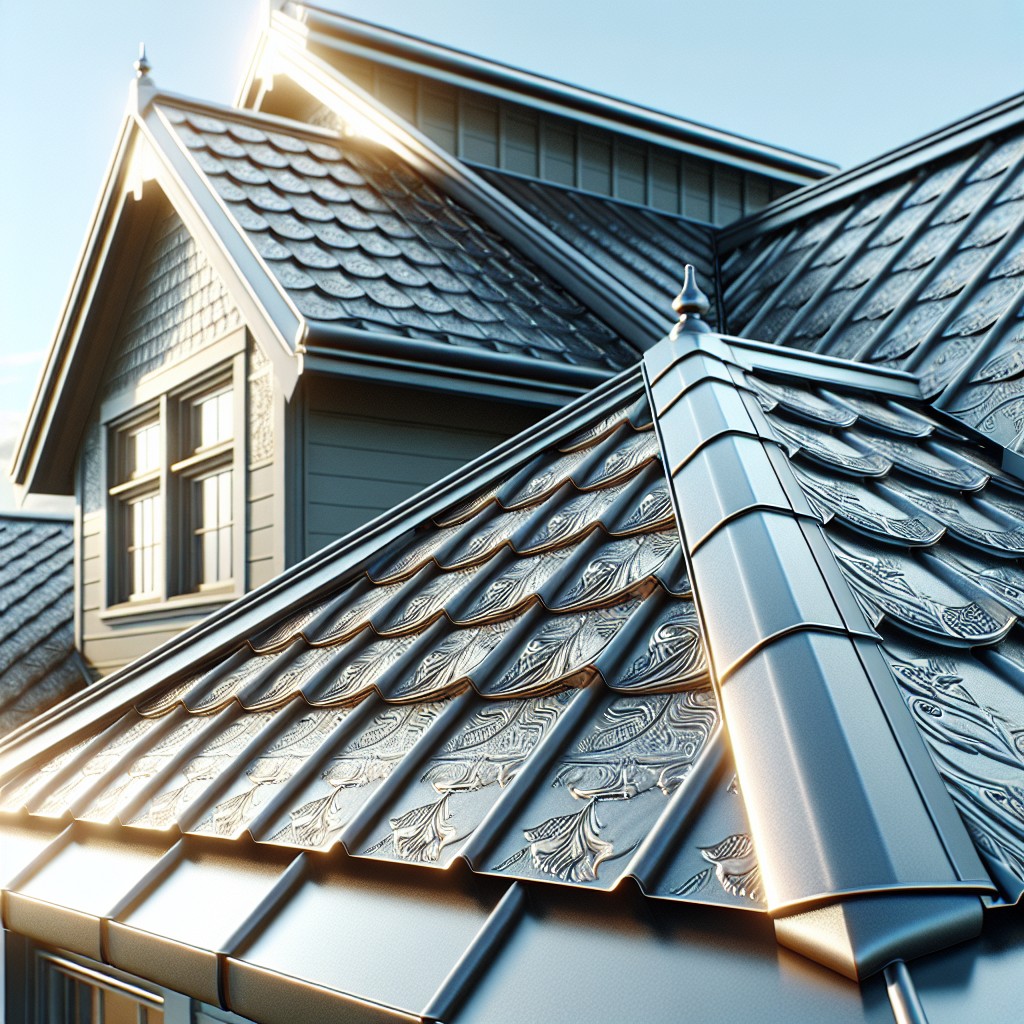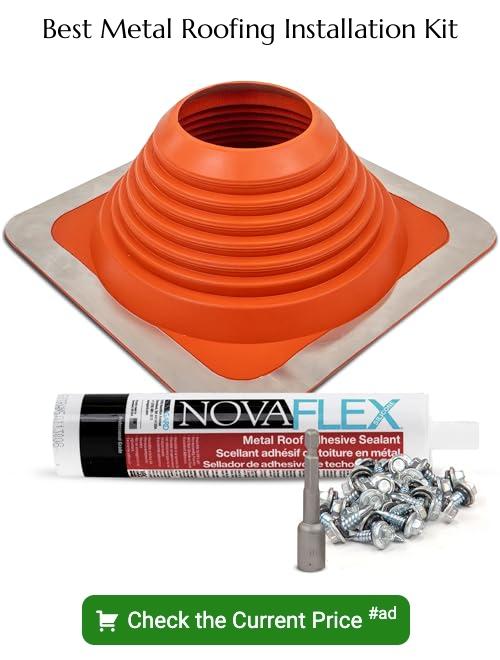Last updated on
Dive into the world of roofing as we dissect the quirks and qualities of metal shingles and standing seam, providing a comprehensive comparison guide, because knowing the difference could significantly transform your roofing experience.
Key takeaways:
- Stamped metal shingles mimic traditional roofing materials, offer aesthetic versatility.
- Standing seam metal roofing features raised interlocking seams for durability.
- Stamped metal shingles are lightweight, easy to install, and offer depth to roof appearance.
- Standing seam roofs are sleek, long-lasting, weather-resistant, and energy-efficient.
- Consider budget, application, style, material and labor costs when choosing roofing.
Stamped Metal Shingle Roofing – Characteristics

Stamped metal shingles mimic the appearance of traditional roofing materials such as wood shake, slate, and tile, but with the durability of metal. They come in a variety of colors, finishes, and shapes, offering aesthetic versatility. Each shingle is coated with a corrosion-resistant material, such as galvanized steel or aluminum, which is then finished with a high-quality paint to enhance longevity and reflectivity.
These metal shingles are lightweight, making them suitable for a wide range of structures without needing additional reinforcement. The interlocking design allows for a more straightforward installation process and provides added resistance to wind uplift. Furthermore, the metal composition is non-combustible, offering increased fire resistance. With their layered look, stamped metal shingles offer depth to a roof’s appearance, striking a balance between modern performance and traditional design.
Advantages and Disadvantages of Stamped Metal Shingle Roofing

Stamped metal shingles offer a visually appealing option, closely resembling traditional materials like wood, slate, or tile. Lightweight and easy to install, they are an excellent choice for homeowners looking to upgrade without adding stress to the structure of their homes. Their interlocking design enhances durability, helping to resist high winds and storm-related damage. In terms of maintenance, periodic inspections suffice, as debris and snow easily slough off.
However, homeowners should be aware of potential drawbacks. While they are robust, individual shingles can be prone to denting when subjected to severe hail or falling branches. The initial cost, generally higher than traditional asphalt shingles, may also be a consideration for those on a tight budget. Additionally, professional installation is recommended to ensure that the roof performs as intended, which can further add to the upfront cost.
Standing Seam Metal Roofing – Characteristics
Standing seam metal roofing features a series of panels with raised interlocking seams, which connect adjacent panels together. This design creates a uniform, sleek appearance and offers a high level of durability. The concealed fastener system inherent to this type of roofing safeguards against water penetration, making it excellent for weatherproofing.
Notably, this roofing option is available in various materials such as galvanized steel, aluminum, and copper, each offering different aesthetic and performance benefits. The panels can be finished with a variety of coatings to enhance their reflective properties and resistance to corrosion, often contributing to energy efficiency gains.
Installation typically requires specialized tools and expertise due to the precise nature of the seaming process. The panels are often custom-fabricated to the exact length of the roof, eliminating horizontal seams and thus reducing potential failure points. This roofing’s adaptability makes it suitable for both modern and traditional architecture, with a range of color and profile options to match any design vision.
Advantages and Disadvantages of Standing Seam Metal Roofing
Standing seam metal roofing offers a sleek, modern appearance with its continuous panels that run from the ridge of the roof to the eaves. The seams where these panels interlock are raised above the level of the roofing itself, giving these roofs their distinctive appearance and their name.
One significant advantage of this system is its durability and longevity; standing seam roofs typically last up to 50 years or more with minimal maintenance. They are also exceptionally weather-resistant, standing up to high winds, heavy rains, and snow because of their secure interlocking panels and lack of horizontal seams, which are potential weak points for water ingress.
Moreover, these roofs are energy efficient, often made from recyclable materials and capable of reflecting solar heat, thus reducing cooling costs in warmer climates. For those seeking an eco-friendly option, the materials used in standing seam roofs are often 100% recyclable at the end of their life.
However, standing seam roofing systems can be more costly than other options due to the high quality of materials and the specialized labor required for installation. The importance of proper installation cannot be overstated; if not correctly installed, even the best materials can fail, leading to costly repairs.
Furthermore, while the unique look of standing seam roofs is appealing to many, it may not blend well with every architectural style, particularly in neighborhoods with strict aesthetic codes or historical homes.
Lastly, walking on these types of roofs without the proper knowledge or tools can dent the roofing panels or damage the seams. Therefore, maintenance and repair should always be carried out by professionals experienced in handling standing seam metal roofs.
How to Determine Your Roofing Needs: Budget, Application, and Style
Selecting the right roofing for your home is a tailored process involving an evaluation of several key factors. Consider your budget first; not only should you account for initial material and installation costs but also long-term maintenance and potential energy savings.
Next, reflect on the application, which involves assessing the climate you live in and the demands it places on roofing materials – metal shingles might be ideal in hail-prone areas whereas standing seam could excel in heavy snowfall regions.
Lastly, style should not be overlooked – the aesthetic of your roof should complement your home’s architecture. Metal shingles offer a traditional look, akin to asphalt shingles, while standing seam provides a sleek, contemporary appearance.
Balancing these elements will guide you towards a roofing solution that meets your needs practically and visually.
Understanding Material, Size, and Labor Costs
When selecting between metal shingles and standing seam roofing, material costs will vary based on type and quality. Metal shingles often use aluminum, steel, or copper, with prices dependent on the metal’s gauge and finish. Standing seam panels, typically made of similar materials, may cost more per square foot due to the larger uninterrupted pieces.
Size plays a crucial role; a larger roof requires more materials and time to install, increasing the overall cost. It is important to have accurate measurements to estimate material needs correctly.
Labor costs are influenced by the complexity of the installation. Metal shingles may be more labor-intensive, with individual pieces needing to be fastened. In contrast, the installation of standing seam systems, which involves long, single panels, requires specialized skills and tools, often leading to higher labor rates.
Lastly, don’t overlook the potential for additional costs like underlayment, fasteners, and trim pieces. An understanding of these factors will aid in crafting a comprehensive budget for your roofing project.
Comparing DIY Vs. Professional Roof Installation
The choice between DIY and professional installation can hinge on several critical factors:
- Expertise: Professional roofers bring extensive knowledge and experience, necessary for tackling complex issues and ensuring proper installation. DIY enthusiasts must assess their skills realistically before attempting installation.
Time: A professional team can complete a roofing project much faster than an individual. Consider the value of your time and the urgency of the project.
Tools and Equipment: Professionals have access to high-grade tools and safety equipment, which might be cost-prohibitive for a one-time DIY project.
Warranty and Guarantees: Roofing installed by licensed professionals often comes with warranties for material and labor. DIY installations might void material warranties.
Safety: Roofing is a high-risk task. Without proper training and equipment, the risk of injury can be significant.
Building Codes and Permits: Professionals are familiar with local building codes and can ensure that the installation is compliant, navigating permits seamlessly.
When deciding between DIY and professional installation, weigh the risks against potential savings. Expert installation can provide peace of mind, potentially better longevity, and adherence to safety and legal requirements.
Advantages of Metal Roofs Vs. Shingle Roofs: Value and Longevity
Metal roofs are celebrated for their durability, often lasting 40 to 70 years, depending on the material, which is significantly longer than the average asphalt shingle roof’s 15 to 20-year lifespan. This extended durability means fewer replacements over time, potentially saving homeowners money in the long term. Additionally, metal roofing materials are typically non-combustible, granting them a Class A fire rating – the highest level of resistance to fire.
Another value that metal roofs offer is energy efficiency. They reflect solar radiant heat, which can reduce cooling costs by 10-25%. The recyclability of metal roofs is also a point of value; they are often made from recycled materials and can be fully recycled at the end of their lifespan, appealing to environmentally conscious homeowners.
Furthermore, metal roofs can increase a home’s resale value. According to some estimates, homeowners can recoup up to 85% of costs on a metal roof at resale due to their longevity and low maintenance needs. Their modern appearance and array of available colors and styles additionally enhance curb appeal, allowing for aesthetic versatility.
How To Hire a Professional Roofer
When selecting a professional roofer, prioritize those who are licensed and insured. This credentialing minimizes your liability and guarantees a standard of workmanship. Experience is also key; look for contractors with a solid track record of installing your chosen roofing type.
Solicit multiple bids to ensure competitive pricing but be wary of quotes that seem unusually low as they may reflect subpar materials or service. Check references and online reviews to gauge customer satisfaction, and insist on a detailed contract that outlines the scope of the project, including timelines and materials.
Lastly, ensure there’s a clear warranty for both materials and labor.
FAQ
Are metal shingles more expensive than standing seam?
Yes, typically, metal shingle roofs are more expensive than standing seam roofs.
Is it better to have a metal roof or shingles?
Considering factors such as durability and performance under extreme weather conditions, a metal roof, with a potential lifespan of up to 80 years, is generally superior to a shingle roof that typically lasts for 20 to 30 years.
When should you not use a metal roof?
You should not use a metal roof if you live in a coastal climate due to the potential for rust, particularly with certain types of metal like steel, and aesthetic concerns surrounding materials like aluminum.
What is the biggest problem with metal roofs?
The biggest problem with metal roofs is that they can amplify noises, especially during instances of heavy rain or hail.
How does the installation process differ between metal shingles and standing seam roofs?
The installation process differs as metal shingles are individually installed and nailed directly into the roof deck, while standing seam roofs are installed in large, continuous panels that run from the ridge to the eaves and secured with hidden fasteners.
Can metal roofs withstand extreme weather conditions better than shingles?
Yes, metal roofs generally have higher resistance to extreme weather conditions than shingle roofs.
What are the maintenance requirements for metal shingles vs standing seam roofs?
Metal shingle roofs require regular inspection for potential damage, while standing seam roofs demand periodic fastener tightening and seam examination to ensure proper functionality.





